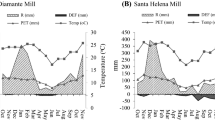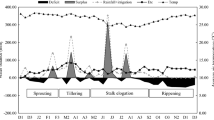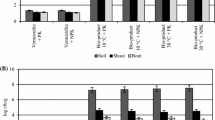Abstract
A field experiment was conducted for three consecutive years to study the effect of set treatment of Gluconacetobacter diazotrophicus and PSB on seed yield, quality and saving of chemical N and P fertilizers for sugarcane seed plot. The set inoculation of Gluconacetobacter diazotrophicus + PSB coupled with 75 % recommended N and 75 % recommended P2O5 significantly improved the growth, two eye bud-set yield and quality. Among fertilizer levels, 75 % recommended N and 75 % recommended P recorded the highest yield of two eye bud-sets (883.63 and 885.44 thousands/ha, respectively). Between the inoculation treatments, fresh planting material inoculated with Acetobacter recorded higher two eye bud-sets (858.96 thousands/ha) than the uninoculated planting material from previous-year Acetobacter inoculated plot (828.47 thousands/ha); however, they were statistically indistinguishable. Moreover, the higher population and activity of G. diazotrophicus were observed at 75 % recommended N and 75 % recommended P. Among various interactions, the interaction of 75 % N and inoculation treatment showed significantly highest Acetobacter count in cuttings (7.38 × 104). The available N and P status of soil at harvest was significantly influenced by different fertilizer levels (N and P levels), inoculation treatments and their interactions as well.




Similar content being viewed by others
References
Aneja, K.R. 2003. Experiments in microbiology, plant pathology and biotechnology, 1–607. New Delhi: New Age International Publishers.
Bhor, S.V., C.D. Deokar, D.M. Sawant, and R.B. Sonawane. 2006. Studies on effect of Acetobacter diazotrophicus biofertilizer on growth and quality parameters in sugarcane. Journal of Maharashtra Agricultural Universities 31(2): 219–221.
Cavalcante, V.A., and J. Dobereiner. 1988. A new acid tolerant nitrogen fixing bacterium associated with sugarcane. Plant and Soil 108: 23–31.
Chauhan, H., A. Sharma, and S.K. Saini. 2010. Response of sugarcane to endophytic bacterial inoculation. Indian Journal of Sugarcane Technology 25(1&2): 1–4.
Fuentez-Ramirez, L.E., J. Caballero-Mellado, J. Sepul-Veda, and E. Martinez-Romero. 1999. Colonization of sugarcane by Acetobacter diazotrophicus is inhibited by high N fertilization. FEMS Microbial Ecology 29: 117–128.
Fuentez-Ramirez, L.E., T. Jiminez-Salgado, I.R. Abarca-Ocampo, and J. Caballero-Mellado. 1993. Acetobacter diazotrophicus, an indoleacetic acid producing bacterium isolated from sugarcane cultivars in Mexico. Plant and Soil 154: 145–150.
Hari, K. 1995. Biofertilizers in sugarcane. Lead paper presented in 10th Sugarcane Research and Development Workers’ Meeting for South Karnataka, Shimoga, Karnataka, India.
Jackson, M.L. 1967. Soil chemical analysis. New Delhi: Prentice Hall of India Pvt. Ltd.
Kathiresan, G. 2008. Influence of organics and biofertilizers with graded levels of major nutrients on sugarcane yield, quality and economics under the soil having low, low and medium status of NPK. Cooperative Sugar 39(10): 45–49.
Li, R., and I.C. MacRae. 1991. Specific association of diazotrophic Acetobacter with sugarcane. Soil Biology & Biochemistry 23: 999–1002.
Muthukumarasamy, R., G. Revathi, and A.R. Solayappan. 1994. Biofertilizer—A supplement or substitute for chemical nitrogen for sugarcane crop. Cooperative Sugar 25: 287–290.
Muthukumarasamy, R., G. Revathi, S. Seshadri, and C. Lakshminarasimhan. 2002. Gluconacetobacter diazotrophicus (syn. Acetobacter diazotrophicus), a promising diazotrophic endophyte in tropics. Current Science 83(2): 138–145.
Panse, V.S., and P.V. Sukhatme. 1985. Statistical methods for agricultural workers. New Delhi: ICAR.
Reis, V.M., F.L. Olivares, and J. Dobereiner. 1994. Improved methodology for isolation of Acetobacter diazotrophicus and confirmation of its habitat. World Journal of Microbiology & Biotechnology 10: 101–104.
Srinivasan, T.R., and K.M. Naidu. 1987. Response of sugarcane varieties to biofertilizers under different soil conditions. Sugarcane 3: 5–11.
Suman, A. 2003. Biological nitrogen fixation in relation to improving sugarcane productivity. In Summer School held at I.I.S.R., Lucknow, vol. 15, 61–64.
Tejera, N.A., E. Ortega, J. Ganzalez-Lopez, and C. Lluch. 2003. Effect of some abiotic factors on the biological activity of Gluconacetobacter diazotropics. Journal of Applied Microbiology 95: 528–1002.
Author information
Authors and Affiliations
Corresponding author
Ethics declarations
Conflict of interest
None.
Rights and permissions
About this article
Cite this article
Murumkar, D.R., Nalawade, S.V., Indi, D.V. et al. Response of Sugarcane Seed Plot to Microbial Inoculation by Gluconacetobacter diazotrophicus and Phosphate-Solubilizing Bacteria. Sugar Tech 19, 26–32 (2017). https://doi.org/10.1007/s12355-016-0432-3
Received:
Accepted:
Published:
Issue Date:
DOI: https://doi.org/10.1007/s12355-016-0432-3




